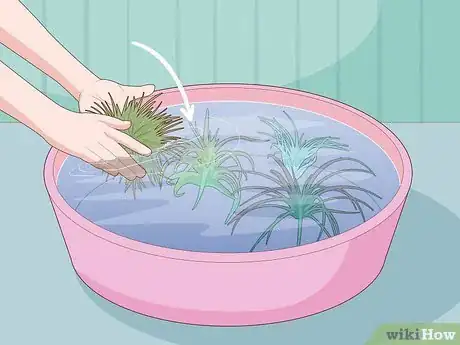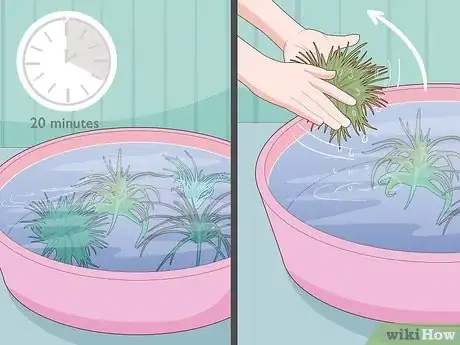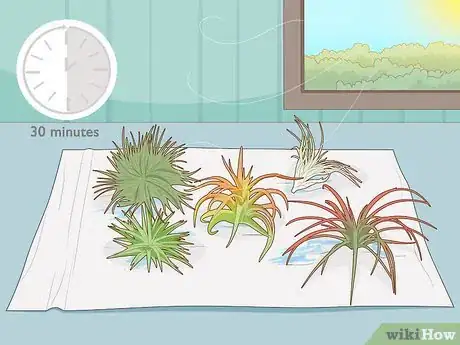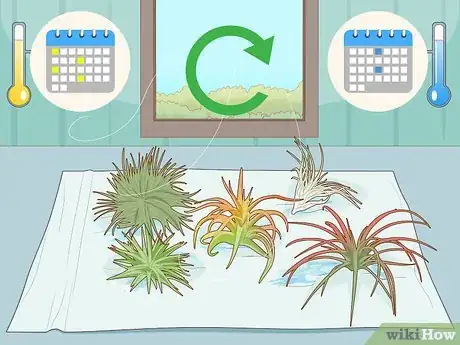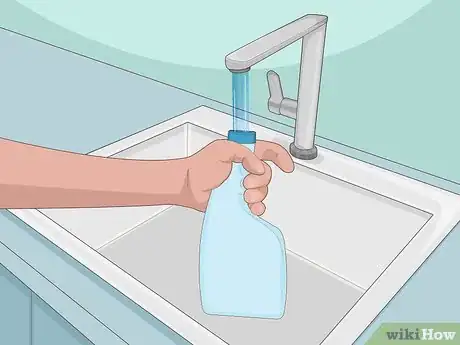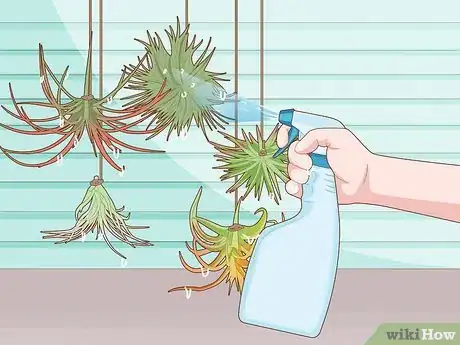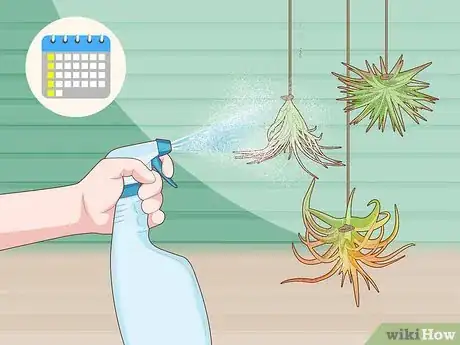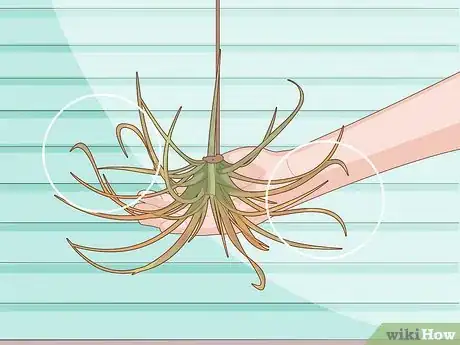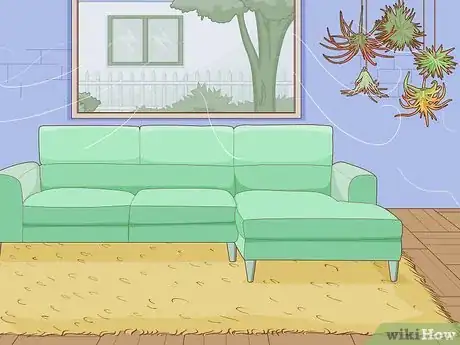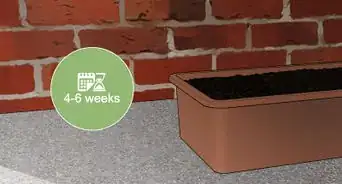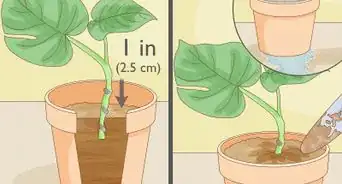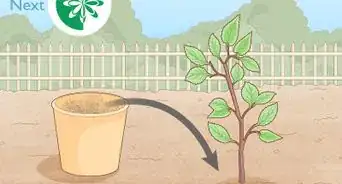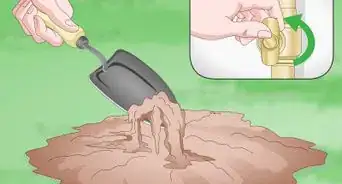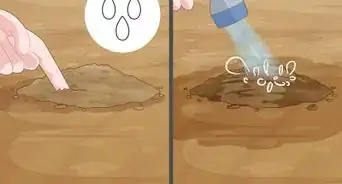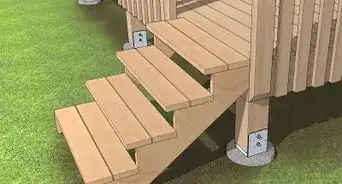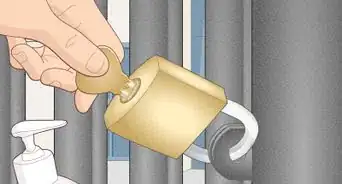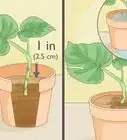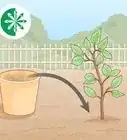This article was co-authored by Harmony Corelitz and by wikiHow staff writer, Amber Crain. Harmony Corelitz is a Plant Specialist and the Ecommerce Manager at Crimson Horticultural Rarities, Inc, a boutiue offering rare plants, flower arragements, and handmade goods. Harmony grew up helping her parents run their family business in plant maintenance and interior plantscaping. Harmony specializes in indoor plant care and interior plant design. Prior to her workwith Crimson Horticultural Rarities, she started her pop-up plant and vintage home goods shop called Younger Child and helped her former employer, Plants and Friends, grow and expand to two locations. She holds a BA from the University of San Francisco.
This article has been viewed 35,350 times.
Air plants, also known as Tillandsia, are popular, low-maintenance houseplants that don’t grow in soil. Instead, they pull the bulk of their needed nutrients from the air! To keep your air plant healthy and happy, it needs water about once a week. Bottled or filtered tap water works best—avoid watering your air plants with distilled water since the distillation process removes important nutrients.
Steps
Soaking Loose Air Plants
-
1Fill a clean tub, bucket, or sink with bottled or filtered tap water. Choose a container or receptacle that can easily accommodate all of your air plants. Add room-temperature bottled or filtered tap water to the container. Make sure you use enough water to fully submerge each clump.[1]
- Always clean out the container before using it to water your air plants.
- Avoid using distilled water for this since the distillation process removes crucial nutrients.[2]
-
2Submerge your air plants in the water. Air plants don’t grow in pots or soil, so you can easily gather the small, loose clumps with your hands. Place each clump in the water bath and push it under the surface. You can soak multiple air plants simultaneously.[3]
- If your air plant is mounted to a surface, like a heavy shell or piece of driftwood, you'll probably need to mist it instead of submerging it.
Advertisement -
3Soak the plants for 15 minutes and shake off the excess water. The air plants may float up to the surface as they soak, which is fine—just make sure the majority of each clump stays submerged for the full 15 minutes. Then, grab each clump, remove it from the bath, and shake it off to get rid of excess water.[4]
- Excess water tends to collect between the center leaves if you don’t give them a gentle shake first, which can eventually lead to rot and other issues.
- If your air plants are particularly dry, leave them in the water for up to 1 hour.[5]
-
4Place each clump upside down on a paper towel to air-dry completely. Air-drying typically takes about 30 minutes, but large or intricate clumps can take longer. You can touch the center leaves with your fingertips to check for moisture. Return the plants to their original locations once they’re totally dry.[6]
- Always place clumps upside down to air-dry so excess moisture can drain away.
-
5
Misting Mounted Air Plants
-
1Fill a plastic spray bottle with bottled or filtered tap water. Use room-temperature water for the best results. Be sure to avoid using distilled water, which doesn’t contain the necessary nutrients your air plants need to thrive.[9]
-
2Spray each clump generously until the water is dripping off the leaves. Misting delivers enough water to your air plant as long as you’re generous and thorough. Saturate the plant until water is running off the leaves.[10]
- Mounted air plants often need to be misted because the object they're attached to can’t be submerged in water. If the object is porous, bulky, or heavy, it's better to mist the plants.
-
3Mist your air plants at least once a week to keep them hydrated. Since they’re tropical or subtropical in nature, air plants will not last long without steady moisture.[11] Thoroughly mist them at least once a week.
-
4Water your plants more often if you notice signs of dehydration. Air plants can dry out more easily if you’re unable to submerge them in water. To prevent dehydration, watch for leaves that feel soft or look pale green. Leaves may also curl or roll up when they are dehydrated.[12]
- Extremely dehydrated leaves may turn brown and brittle at the tips.[13]
- A hydrated air plant will look lush with darker green leaves.
-
5Place mounted air plants in a location that gets good air circulation. Unevaporated moisture can cause air plants to rot. Keeping mounted air plants in an area that gets plenty of air circulation so the leaves can dry completely after each misting session.[14]
- For example, a spacious, uncluttered room that gets plenty of light is a great place for your air plants.
- Make sure the surface your air plant is mounted on does not hold or absorb water. For example, cork would not be a good surface because it soaks up water like a sponge.
- Remember, your air plants need plenty of bright light, so keep that in mind when you're deciding where to put them. If they're indoors, keep them within 3–7 ft (0.91–2.13 m) of a window.[15]
Expert Q&A
Did you know you can get expert answers for this article?
Unlock expert answers by supporting wikiHow
-
QuestionHow much light do air plants need?
 Harmony CorelitzHarmony Corelitz is a Plant Specialist and the Ecommerce Manager at Crimson Horticultural Rarities, Inc, a boutiue offering rare plants, flower arragements, and handmade goods. Harmony grew up helping her parents run their family business in plant maintenance and interior plantscaping. Harmony specializes in indoor plant care and interior plant design. Prior to her workwith Crimson Horticultural Rarities, she started her pop-up plant and vintage home goods shop called Younger Child and helped her former employer, Plants and Friends, grow and expand to two locations. She holds a BA from the University of San Francisco.
Harmony CorelitzHarmony Corelitz is a Plant Specialist and the Ecommerce Manager at Crimson Horticultural Rarities, Inc, a boutiue offering rare plants, flower arragements, and handmade goods. Harmony grew up helping her parents run their family business in plant maintenance and interior plantscaping. Harmony specializes in indoor plant care and interior plant design. Prior to her workwith Crimson Horticultural Rarities, she started her pop-up plant and vintage home goods shop called Younger Child and helped her former employer, Plants and Friends, grow and expand to two locations. She holds a BA from the University of San Francisco.
Plant Specialist A lot of people think that air plants don't need a lot of natural light, but they actually need a lot of bright, filtered sun. If you have a north-facing or east-facing window, I suggest keeping your air plant within 3 feet of the window. If your windows face South or West, you can keep the plant a little further away so they don't get a sunburn—maybe 3-7 feet.
A lot of people think that air plants don't need a lot of natural light, but they actually need a lot of bright, filtered sun. If you have a north-facing or east-facing window, I suggest keeping your air plant within 3 feet of the window. If your windows face South or West, you can keep the plant a little further away so they don't get a sunburn—maybe 3-7 feet. -
QuestionHow do you soak an air plant?
 Harmony CorelitzHarmony Corelitz is a Plant Specialist and the Ecommerce Manager at Crimson Horticultural Rarities, Inc, a boutiue offering rare plants, flower arragements, and handmade goods. Harmony grew up helping her parents run their family business in plant maintenance and interior plantscaping. Harmony specializes in indoor plant care and interior plant design. Prior to her workwith Crimson Horticultural Rarities, she started her pop-up plant and vintage home goods shop called Younger Child and helped her former employer, Plants and Friends, grow and expand to two locations. She holds a BA from the University of San Francisco.
Harmony CorelitzHarmony Corelitz is a Plant Specialist and the Ecommerce Manager at Crimson Horticultural Rarities, Inc, a boutiue offering rare plants, flower arragements, and handmade goods. Harmony grew up helping her parents run their family business in plant maintenance and interior plantscaping. Harmony specializes in indoor plant care and interior plant design. Prior to her workwith Crimson Horticultural Rarities, she started her pop-up plant and vintage home goods shop called Younger Child and helped her former employer, Plants and Friends, grow and expand to two locations. She holds a BA from the University of San Francisco.
Plant Specialist Fill a large bowl or your sink with water and fully submerge the plant for about 15 minutes. That allows the plant to drink out of the hairs on its leaves. Then, shake the plant out and dry it upside-down to make sure it's not holding moisture in any of its crases. Once it's dry, just put it back where it was. Do this about once a week.
Fill a large bowl or your sink with water and fully submerge the plant for about 15 minutes. That allows the plant to drink out of the hairs on its leaves. Then, shake the plant out and dry it upside-down to make sure it's not holding moisture in any of its crases. Once it's dry, just put it back where it was. Do this about once a week. -
QuestionIs it better to soak or mist an air plant?
 Harmony CorelitzHarmony Corelitz is a Plant Specialist and the Ecommerce Manager at Crimson Horticultural Rarities, Inc, a boutiue offering rare plants, flower arragements, and handmade goods. Harmony grew up helping her parents run their family business in plant maintenance and interior plantscaping. Harmony specializes in indoor plant care and interior plant design. Prior to her workwith Crimson Horticultural Rarities, she started her pop-up plant and vintage home goods shop called Younger Child and helped her former employer, Plants and Friends, grow and expand to two locations. She holds a BA from the University of San Francisco.
Harmony CorelitzHarmony Corelitz is a Plant Specialist and the Ecommerce Manager at Crimson Horticultural Rarities, Inc, a boutiue offering rare plants, flower arragements, and handmade goods. Harmony grew up helping her parents run their family business in plant maintenance and interior plantscaping. Harmony specializes in indoor plant care and interior plant design. Prior to her workwith Crimson Horticultural Rarities, she started her pop-up plant and vintage home goods shop called Younger Child and helped her former employer, Plants and Friends, grow and expand to two locations. She holds a BA from the University of San Francisco.
Plant Specialist My preferred way of watering an air plant is to soak it. When you're misting, sometimes you may not get moisture to every part of the plant. Also, you have to mist daily, because air plants rely on humidity for moisture. However, they're not really used to being wet all the time, so misting them can cause them to rot.
My preferred way of watering an air plant is to soak it. When you're misting, sometimes you may not get moisture to every part of the plant. Also, you have to mist daily, because air plants rely on humidity for moisture. However, they're not really used to being wet all the time, so misting them can cause them to rot.
Things You’ll Need
Soaking Loose Air Plants
- Tub, bucket, or sink
- Bottled or filtered tap water
- Paper towels
Misting Mounted Air Plants
- Plastic spray bottle
- Bottled or filtered tap water
References
- ↑ Harmony Corelitz. Plant Specialist. Expert Interview. 4 December 2020.
- ↑ https://www.youtube.com/watch?v=xCqAJh0vv1k&feature=youtu.be&t=125
- ↑ https://hgic.clemson.edu/factsheet/air-plants/
- ↑ Harmony Corelitz. Plant Specialist. Expert Interview. 4 December 2020.
- ↑ https://gardentherapy.ca/water-air-plants/
- ↑ Harmony Corelitz. Plant Specialist. Expert Interview. 4 December 2020.
- ↑ https://gardeningsolutions.ifas.ufl.edu/plants/houseplants/air-plants.html
- ↑ https://hortnews.extension.iastate.edu/2019/12/all-about-air-plants
- ↑ https://www.youtube.com/watch?v=xCqAJh0vv1k&feature=youtu.be&t=125
- ↑ https://gardeningsolutions.ifas.ufl.edu/plants/houseplants/air-plants.html
- ↑ https://hgic.clemson.edu/factsheet/air-plants/
- ↑ https://gardeningsolutions.ifas.ufl.edu/plants/houseplants/air-plants.html
- ↑ https://hgic.clemson.edu/factsheet/air-plants/
- ↑ https://gardeningsolutions.ifas.ufl.edu/plants/houseplants/air-plants.html
- ↑ Harmony Corelitz. Plant Specialist. Expert Interview. 4 December 2020.


